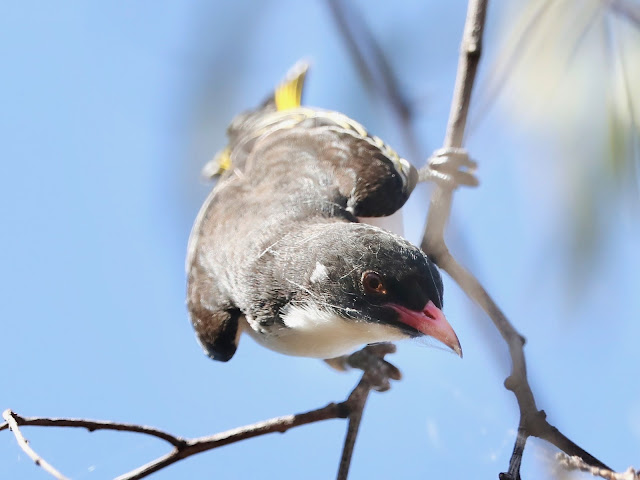At the start of a walk to the Granites in Currawinya National Park in south-west Queensland I caught a brief glimpse of a honeyeater in a Wilga tree (Geijera parviflora) which I thought was a Painted Honeyeater however before I could raise my bins to confirm it, a Spiny-cheeked Honeyeater chased the bird out of the tree. Given Painted Honeyeaters (Grantiella picta) are elusive and rarely observed I was somewhat disappointed to have missed a close sighting of the species and a possible photo opportunity.
An hour or so later we returned to the start of the walk and were enjoying a cuppa in the shade of the Wilga tree when a Painted Honeyeater turned up in the dead branches of an adjoining tree, allowing confirmation of my earlier tentative ID. Naturally I was keen to capture some photos of this elusive bird and managed 21 hurried photos in quick succession. However I felt I had not captured one acceptable photo as the bird darted this way and that, not stopping for long in any of its many positions. Somewhat disappointed we moved on and I did not give the photos any further thought until they were downloaded to my laptop and I looked through them. Before I describe the story the photos later revealed, some background information on this unusual honeyeater will provide some context.
The Painted Honeyeater, an Australian endemic, is unique, being the only frugivore honeyeater - a dietary specialist largely dependent on the fruit of mistletoe plants. Their migratory and nomadic movements are influenced by fruiting mistletoe. Described as rare and elusive, they generally can’t be found easily, so observing them is uncommon with most encounters by pure chance. Their distinctive call, once learnt, is a good way of detecting this elusive species.
Now back to the photos which on close inspection revealed two activities of interest. I first noticed in some photos that the bird was collecting spider webs, not apparent in the field when I was preoccupied with the camera. This explained why the bird moved about so rapidly and erratically in the dead branch and why capturing good photos was a challenge.
Of course the gathering of webs indicated the bird was building a nest. Given the bird was nest building this breeding attempt showed there must have been at least two Painted Honeyeaters and enough fruiting mistletoe to support a breeding attempt. There were significant stands of Mulga (Acacia aneura) in the area carrying mistletoe.
The following six photos show the Painted Honeyeater collecting spider webs.
Please click on photos to enlarge.
The second point of interest was found in the first photo taken which revealed the bird defecating a short string of mistletoe fruit, (see photo below) which in turn led me to think about the relationship between mistletoe and the Painted Honeyeater.
By chance I had recently read David Watson’s excellent book, Mistletoes of Southern Australia(1), where he describes the role of Painted Honeyeaters in mistletoe’s deep time speciation and radiation in Australia – there are some seventy mistletoe species, usually with special relationships with particular tree species.
It is well known that today in Australia the Mistletoebird(2), an extreme dietary specialist, is largely responsible for the survival and spread of mistletoe. However molecular studies have shown the Mistletoebird, a flowerpecker species, arrived in Australia from Asia less than 1 million years ago, well after Australia’s diverse mistletoe species had evolved and spread across the continent. The Painted Honeyeater diverged from northern Queensland and New Guinea rainforest frugivores some 16 million years ago, well before the Mistletoebird’s arrival in Australia. David Watson provides a more detailed description of this story in his book where he, with justification, claims the Painted Honeyeater was Australia’s original mistletoe bird.
One of the big attractions of birding for me is demonstrated by the above experience - a chance encounter in outback Queensland with an elusive honeyeater can lead to an understanding and appreciation of the deep time evolution and spread across Australia of a diversity of ecologically important parasitic plant species and their co-dependent relationship with a bird species.
(1) My title for this post is borrowed from David M Watson, author of Mistletoes of Southern Australia, Illustrations by Robyn Hully, CSIRO Publishing (see page 135).
(2) This early Avithera post features a Mistletoebird extracting a seed from a mistletoe fruit. https://avithera.blogspot.com/2013/06/mistletoebird.html







No comments:
Post a Comment